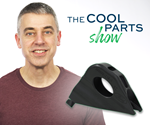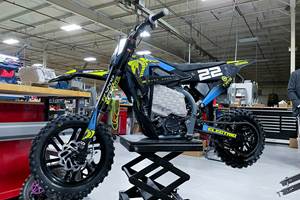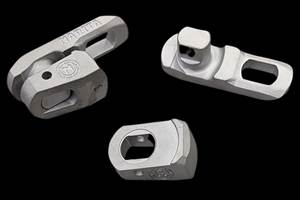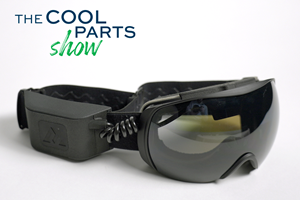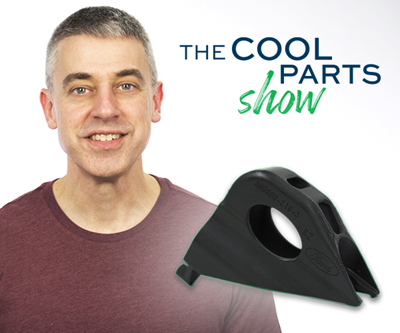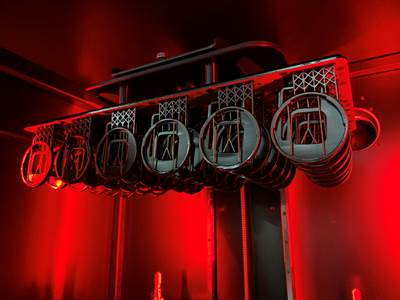Dustless Technologies has relied on overseas manufacturing for years, particularly to make mold tooling, but the shift to 3D printing away from injection molding is allowing the Utah-based maker of wet-dry vacuums and accessories to increase its part production in the United States. The new DustBuddie attachment for jackhammers is the company’s first entirely U.S.-made product in decades, produced through additive manufacturing via digital light processing (DLP). In this episode, Dustless’s CEO describes the opportunities for reshoring with 3D printing and the leadtime savings and other advantages of 3D printing over molding. | This episode of The Cool Parts Show brought to you by Carpenter Additive
The Cool Parts Show is a video series from Additive Manufacturing Media that explores the what, how and why of unusual 3D printed parts. Watch more here.
Have a cool part to share? Email us.
Related Resources
- Dustless Technologies
- More on Dustless’s shift to AM
- Merit3D
- DLP for Ford part production
- Adaptive3D
Transcript
Peter Zelinski
Thanks to 3D printing, manufacturing returns to the United States. Reshoring, on this episode of The Cool Parts Show.
Stephanie Hendrixson
This episode of The Cool Parts Show is brought to you by Carpenter Additive.
Peter Zelinski
We're at the company's powder production facility in Athens, Alabama.
Stephanie Hendrixson
Specifically, we are standing on top of the Z1, the company's largest vacuum atomizer for producing metal powders.
Peter Zelinski
Want to know how to make metal powder for additive manufacturing? Stick around after the episode.
Peter Zelinski
I'm Pete
Stephanie Hendrixson
I'm Stephanie.
Peter Zelinski
Welcome to The Cool Parts Show.
Stephanie Hendrixson
This is our show all about cool, unique, interesting 3D printed parts. And Pete it looks like maybe you stopped at the hardware store on your way in today.
Peter Zelinski
Kind of looks like that. Yeah, so this is a retail product. It is made for contractors. Bigger picture, this is also a reshoring success story. Manufacturing coming back to the United States, thanks to 3D printing.
Stephanie Hendrixson
Okay, so I really like where this is going. But let's get specific. What is the part?
Peter Zelinski
Right, so the part is the DustBuddie for demo hammers. This is made by Dustless Technologies based in Utah. Dustless makes wet/dry vacuums. And more significantly, maybe what they're better known for is the accessories for wet/dry vacs. They make accessories that can connect your vacuum to power tools, grinders, and in this case to a jackhammer. Controlling dust is becoming more and more of a concern during demolition, particularly with certain types of materials. This is a way to connect your vacuum to your jackhammer and be clean while you're jackhammering.
Stephanie Hendrixson
How was Dustless making products like this up until recently?
Peter Zelinski
Dustless makes some of its components in the U.S., but the largest share of parts that go into its products are polymer, made through molding, made through injection molding. A lot of those components are made overseas. And most significantly, the tooling for this molding work is almost exclusively made overseas. Tooling, a mold tool, a significant item of hardware of capital investment necessary to get started with injection molding. And for Dustless, the mold tooling was was largely a cost driver. This is a company that sells some of its stuff in stores, it sells to consumers, it's in Home Depot. And so its products have to be available at the kind of prices that consumers expect. And for Dustless, this left them going overseas for mold tooling where it could be made less expensively. This was never a situation a predicament that the company was satisfied with. There were challenges to this. Why don't I introduce the CEO of Dustless, Spencer Loveless. He can talk a little bit about the company and the challenges they faced with manufacturing.
Spencer Loveless
So Dustless is a family company. We've been around for 40 years, and my dad invented a vacuum for taking ashes out of wood stoves that evolved to a wet/dry vacuum, which you see behind me today. And then that evolved to different dust collection attachments for tools. So we make attachments for jackhammers, attachments for grinders, and SKIL saws and reciprocating saws and just all types of different products all based in the US. So most of our products are made through injection molding, it's been, you know, injection molding has been around for 100 years and it's a very tried and proven technology. Many of the drawbacks that we see with injection molding are the agility to go to market very, very quickly. The moment that we cut steel, and we start producing a product, almost every single time we always wish there was something we could change on that product. And so we're trying to get away from that being stuck to a very hard tool and be very agile to meet our customers needs in the market.
Stephanie Hendrixson
Okay, so Spencer just described some of the pain points that we've heard from other manufacturers that make plastic parts. You know, these are things that Dustless has been experiencing for years and years. But in the last couple of years, they have made this pivot toward 3D printing, and I wonder if you can just talk a little bit more about that. How did they make this transition?
Peter Zelinski
He is this example of this type of manufacturer, of which there are so many. These companies who recognize that additive manufacturing is the future of their production or is some part of the future of their production and they're watching it. They're watching the technology, they're watching for the right moment to jump in. The technology is changing and moving fast. And Spencer was watching, and he saw the right moment or nearly so. The technology advanced just in those couple years and it came to the point where, yeah, it was close enough and he wanted to commit. And the kinds of things that he was looking at were cost per part, and material availability, and the scalability of production in case dustless really ramped up with this method of manufacturing. I want to let Spencer elaborate on that.
Spencer Loveless
So when we first started exploring 3D printing we had three key elements. The first one was cost, we have to be very competitive with cost. An injection molding pellet for an ABS or polypropylene, it costs anywhere from $1.50 to $3, depending on your fill, and so $3 to $1 a pound, the cost had to be there. The quality has to be there, most of your products that you get injection molded are very good quality. The surface finish is great, it's consistent, you can do it over and over again. And then the third one is the scalability. When you say great your injection mold is done and I need 1000 pieces, or I need 10,000 pieces, or I need 100,000 pieces, you can scale that once your tool is done. and once you've already paid for that. In 3D printing that has been a hinderance and you know, it's still getting over it today. But it's been how do we scale this? If I want one product or I want a million products how do I scale it without breaking the bank?
Stephanie Hendrixson
So Spencer was asking these really good questions about scalability and materials and the process consistency. And he was looking for a 3D printing solution and it seems that he must have found one. Can we talk about the 3D printing technology and the materials that are being used?
Peter Zelinski
Right, right. Process and materials are both important. The 3D printing process, DLP, digital light processing.
Stephanie Hendrixson
Yeah. Okay, so the printer is where you're curing liquid resin to build up the part, photopolymerization.
Peter Zelinski
Right. And the material is also really significant. So this tough, flexible, rubber like material that was produced through 3D printing, this material was developed by Adaptive3D. And the material is a vital consideration and Dustless did a lot of material testing before committing to 3D printing for this product, because it's going to be used with a jackhammer. And it's going to be used by contractors who've got a lot of work to do, and aren't going to be terribly gentle with their equipment. And so finding this tough, resilient rubber like material was really the crucial breakthrough. So this product, has been manufactured in this material on DLP machines from EnvisionTEC at Adaptive3D. And then more recently, it is manufactured at Dustless on a DLP machine from Carima.
Stephanie Hendrixson
That gets at something that you said earlier, when you talked about this as an example of reshoring. Dustless brought manufacturing back to the US, but it's a little bit more than that, they actually brought manufacturing in house in a lot of cases. And I wonder if you can talk more about that, like what does it look like for a company that's used to working with suppliers to actually bring their production in house?
Peter Zelinski
Oh, yeah, I so want to talk about that. So Dustless did sort of final stage assembly, that's what they did. But their components, their parts were all made by someone else and made far away. And the the core of manufacturing is parts, it's making parts. And now Dustless is making their own parts in a growing number of cases. And they've not only brought manufacturing into the US, Dustless is ramping up a manufacturing operation, part making operation. They have hired a manufacturing team, they're adding employees in their community now focused on overseeing this 3D printing capacity, this production capacity that is making components like this and a whole lot of other stuff too.
Stephanie Hendrixson
Okay, so that's really cool. Like this is not just a reshoring story, it's a story about a company that as you say was doing the final assembly, and now they're able to design their products, print them very close by, assemble them and really sort of control that process altogether.
Peter Zelinski
And it's about design and manufacturing living together and making one another better. Dustless is now free to tweak the design and elaborate the design and customize it and tailor it and adapt it and continue to innovate and elaborate the product line. Serve more and more variety of customers and more and more variety of niches. All because the product is no longer tied to a particular geometry that is carved into this expensive hardware mold tool.
Spencer Loveless
So looking over the short horizon, we see Dustless being able to produce at least 100 components via additive manufacturing. The parts that we're going to be producing for Dustless are all vacuum components. Our goal, you can see this vacuum I have here behind me, the molds for that were $750,000 40 years ago, that would be over a million dollar investment today. But we are working on solutions that we can actually 3D print a vacuum is the goal, so that we don't have to invest a million dollars in tooling, but we can invest a million dollars in a 3D printer. Long term, our goals are to have carbon fiber, mass production, rubber mass production, hard parts mass production, large format mass production, and offer it to all these manufacturers that had the same problems and have the same problems that we have at Dustless.
Stephanie Hendrixson
So Spencer mentioned offering these services to other kinds of companies, and, you know, Dustless is still pretty new to 3D printing. So I just wonder, do they have enough work right now to fill their 3D printing capacity?
Peter Zelinski
Sort of. Dustless is in the process right now of figuring out which of its existing components it makes sense to mass produce through 3D printing. They're walking it out, some make sense, some don't. It's a matter of economics, it will continue to be a matter of economics as the technology advances. But yes, right now they do have the work to fill their capacity, including much more capacity than we've talked about. It's also heard from a lot of manufacturers who are facing the same challenge and on the cusp of that same, that same leap that they expect to make. And so Dustless has spun off a sister company, Merit3D, that is applying the company's 3D printers to helping other manufacturers ramp up with production 3D printing, ramp up with additive manufacturing. And in fact, it has faced so much demand for this that so far, it's pretty much just been limited to other companies in Utah. Here's an example. This is a customer of Merit3D, PhoneSkope. PhoneSkope, makes smartphone cases that can connect the phone to lenses, telescopic lenses, microscopic lenses, basically let your phone's camera do a lot more. And phone scope until now has been limited only to serving really popular phone models, because they were molding. They were injection molding, so they could only serve phones of sufficient volume that could justify the mold tooling. Now, thanks to 3D printing, thanks to working with Merit3D PhoneSkope can serve any phone variety, any smartphone variety, even really obscure, unpopular smartphone models. If you order a case for that phone, PhoneSkope will just have it 3D printed.
Stephanie Hendrixson
Yeah. So in the one case, like dustless is a great example of getting away from mold tooling and bringing production closer to home. And PhoneSkope actually kind of takes that a little bit further and gets to the smaller batch sizes and the customization and some of the other benefits from 3D printing.
Peter Zelinski
Yeah, totally true. You ready to wrap this up?
Stephanie Hendrixson
I guess so. So this is the DustBuddie from Dustless Technologies. It's designed to capture dust during jackhammer operation. And until pretty recently, Dustless was making most of their polymer components through injection molding, mostly through suppliers that were overseas, and basically focusing on the design and the final assembly at their facility. But now through 3D printing a couple of different systems that work with DLP, digital light processing technology, they're able to make products and parts like this much closer to home, either within their own facility or through Adaptive3D and their relationship there. And so Dustless is realizing all of these benefits with being able to change the design of the product, to work really closely between design and production to refine the product, make it better, and they've been able to reshore a lot of their production through 3D printing. But it's actually a little bit more than that. They're realizing all of these great benefits with this technology, and they're now also serving other outside customers like PhoneSkope through Merit3D. So this is a great 3D printing story. It's a great win for additive manufacturing for this one company. But what I really like about it is that Dustless is also kind of evangelizing for this technology. They're spreading the benefits around and spreading the knowledge.
Peter Zelinski
We've got a much more detailed article about Dustless, about the 3D printing wins, about where the company is at with 3D printing. We will link to that in the show description. If you've got a 3D printing win, don't keep it to yourself. We want to know about it, it might end up being an episode of the show. Tell us about your cool part, email us CoolParts@AdditiveManufacturing.media.
Stephanie Hendrixson
If you like the show, we hope you'll subscribe, leave us a like, leave us a comment. You can watch all of our episodes at TheCoolPartsShow.com Thanks for watching.
Peter Zelinski
This episode is brought to you by Carpenter Additive, we are at the company's powder production facility in Athens, Alabama. And we are standing on top of an atomizer. The Z1 is Carpenter Technologies largest vacuum atomizer and it is the heart of the process for making additive manufacturing metal powder here at Carpenter Additive.
Stephanie Hendrixson
This facility is capable of producing up to 18,000 pounds of metal powder per day. Plant manager Jordan Ralph talks us through the process.
Jordan Ralph
So an atomizer is a piece of equipment that is capable of melting and pouring molten metal into the stream of high pressure gas that turns that molten metal into tiny tiny droplets that ultimately cool and form our powder, which looks like grey dust. So to start our process and the ultimate end to end solution that we have here, we bring in raw materials, all the way down to individual elements. So nickel, cobalt, chrome, moly niobium, we bring all of those raw materials into the shop. We utilize those materials to build charges that go into the atomizer. As you walk that flow path, you run through our charge makeup area where all of the materials are weighed out in very exact quantities. That ensures that we're able to hit our customer specifications and hold the tight tolerances that we're looking for on a chemistry perspective. From there, the material is flown to the top of the atomizer and charged into the furnace. As material is produced it is poured out and is collected at the bottom of the atomizer. The material is then taken and transferred into a bulk container for processing through the rest of the value stream. The next stop for any of our atomized powder would be the screener. So that will remove the course portion of the powder. From there we take it through air classification, that takes the fine portion of the particle size distribution out and makes the final cut for an additive material like a 10 to 45. From there, we stack up all of those individual lots and put them into the 12,000 pounds blender to make the single homogenous blends. At that point, we are able to pack in any configuration that the customer is looking for, whether that be drums, bottles, PowderTrace hoppers. We've got a lot of options to meet customer's needs. The atomization capability and all of the powder capabilities gives us a unique position where we're actually able to produce the powder, run testing through additive machines all the way through HIP and heat treat, do final testing on those products and then make additional changes or try to optimize things like our chemistry or sizing, so that we ultimately can serve our customers better.
Related Content
New Electric Dirt Bike Is Designed for Molding, but Produced Through 3D Printing (Includes Video)
Cobra Moto’s new all-electric youth motocross bike could not wait for mold tooling. Parts have been designed so they can be molded eventually, but to get the bike to market, the production method now is additive manufacturing.
Read More3DEO Wins Design Excellence Awards
3DEO was recognized for outstanding applications of powder metallurgy.
Read More8 Cool Parts From RAPID+TCT 2022: The Cool Parts Show #46
AM parts for applications from automotive to aircraft to furniture, in materials including ceramic, foam, metal and copper-coated polymer.
Read MoreRekkie AR Ski Goggles Made Possible With 3D Printing: The Cool Parts Show #53
When the electronics enclosure key to these AR goggles proved difficult to mold, 3D printing allowed the inventors to keep the complexity — while also making improvements for assembly and user experience.
Read MoreRead Next
3D Printing for Production at Ford: The Cool Parts Show #7
The parking brake bracket on the Mustang Shelby GT500 is now 3D printed instead of stamped. Learn how Ford is thinking about additive manufacturing in this episode of The Cool Parts Show.
Read MoreAfter Years in China, 3D Printing Lets Vacuum Accessory Maker Develop U.S. Production
The costs of injection molding had Dustless Technologies making tooling and many parts offshore. Additive manufacturing promises an alternative, as in the case of the company's newest product, which is entirely U.S.-made.
Read More4 Ways the Education and Training Challenge Is Different for Additive Manufacturing
The advance of additive manufacturing means we need more professionals educated in AM technology.
Read More


